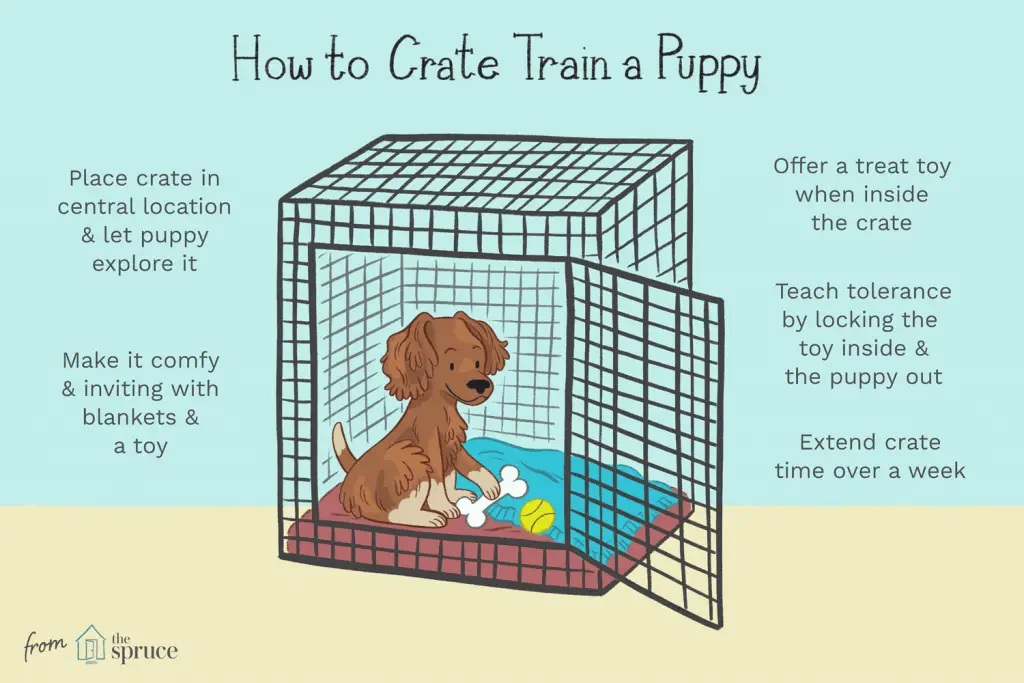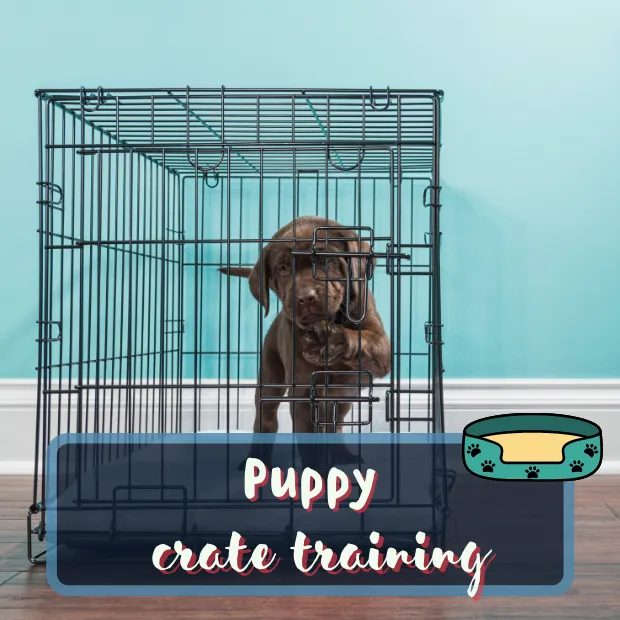If you are like most pet parents, you want your puppy to be house-trained as quickly as possible.
Puppy crate training is a great way to achieve this goal and can help your new family member learn the rules and limits of their world quickly.
Table of Contents
ToggleContents of this article:
- Should I crate train my puppy? The pros and cons of crate training.
- What type of crate?
- Choosing the right size crate.
- How to crate train your puppy.
Should I crate train my puppy? The pros and cons of crate training.
Many new puppy owners ask themselves if they should crate train their dog.
The answer to this question is not always black and white, as there are both pros and cons to crate training.
Crate training can be an extremely effective way to make the housetraining process easier, as well as keep your puppy out of trouble when you can’t watch them.
However, if not done properly, crate training can also lead to behavioral problems.
In this article, we will discuss the pros and cons of crate training your puppy, as well as provide step-by-step guide how to crate train your puppy.
The pros of crate training.
There are several reasons why crate training can be beneficial for your puppy.
Crate training can be an extremely effective way to house-train your pup.
Dogs do not like to soil their sleeping area, so by placing your puppy in their crate when you are unable to watch them, you can help train them learn not to pee or poop in the house.
Crate training can help prevent your puppy from getting into trouble when you’re not able to watch them.
A crate provides a safe, contained space for your pup to relax in without having to worry about them chewing on furniture, wires or getting into other forms of mischief.
For resource guarding dogs, crating can help minimize possession aggression and in multi dog households, crating can help prevent altercations between dogs.
When used properly, the crate can become a place of refuge for your dog, where they know they can go to feel safe and secure and many dogs prefer to sleep in a crate.
In some cases, crates can be good for helping busy dogs find their off switch and calm down.
The cons of crate training.
While crate training has many benefits, it’s important to note that there are also some potential drawbacks to using a crate.
One such downside is that if not done properly, crate training can lead to behavioral problems in puppies.
For example, if a puppy is left in their crate for too long or is made to feel anxious or scared in their crate, they may start to associate the crate with negative feelings and this could escalate into separation anxiety.
As a result, they may begin to avoid the crate altogether, leading to behavioral issues down the road.
Another downside to crate training is that it can be a bit of an inconvenience for some owners as they take up a lot of room.
If you plan to use your crate for travel, for example, you will need to purchase a larger size crate that can accommodate your dog’s size when they are full grown.
What type of crate?
There are several different types of crates to choose from, but the most popular type is the wire crate.
Wire crates are collapsible, making them easy to store and transport, and they provide your puppy with plenty of ventilation and visibility.
Plastic crates are also a popular option, as they are tough and durable and can be easily cleaned. However, they are not as ventilated as wire crates.
Soft crates are made from fabric and are a good option for puppies who are still learning to like their crate, as they are less intimidating than wire crates.
Choosing the right size crate.
Whichever style crate you decide on, when purchasing a crate for your puppy, it’s important to make sure you get the right size.
The crate should be big enough for your pup to stand up, turn around and lie down in comfortably.
If your puppy is still growing, you may want to purchase a crate that will accommodate them when they are full grown.
How to crate train your puppy.
Now that you know the pros and cons of crate training, let’s take a look at how to crate train your puppy. The following steps will outline the basic process of crate training:

- Start by placing the crate in a quiet, comfortable spot in your home. If possible, try to keep the crate close to where the family spends time so your puppy can get used to being around people and other animals.
- Put a piece of vetbed, blanket or towel in the bottom of the crate to make it comfortable.
- Sprinkle some of their favorite treats and leave some chew toys in there for your puppy to find if they venture inside. This will help make a positive association with the crate.
- If your puppy goes into the crate give them lots of praise and throw a few more treats inside
- Feed your puppy their meals in the crate.
- Once your puppy is comfortable going into the crate, start closing the door for short periods of time (start with just a few seconds and work your way up).
- Always make sure all your puppy’s needs are met before leaving them in the crate – that they’ve had a potty trip, had a drink of water, have had some play time, and have something to calm them such as a chewie or a Kong toy stuffed with something tasty.
- Once your puppy is comfortable staying in the crate with the door closed with a chew or a treat toy, practice leaving them in there whilst you go out of sight. Gradually increase the time they spend in the crate.
- If you’re using the crate for travel, start getting your puppy used to it by taking them on short car rides and gradually increasing the length of the ride.
- Never use the crate as a form of punishment – only use it as a positive place for your puppy.
- If your puppy whines or barks when they are in the crate, you may have tried to increase the time too quickly. Wait for the whining behavior to subside before opening the door and in future sessions go back a few steps and build back up.
With a little patience and persistence, you can successfully crate train your puppy using the steps outlined above. Just remember to be consistent and patient with your pup, and to make the crate a positive place for them.
Have a look at some more crate games to play with your pup.







